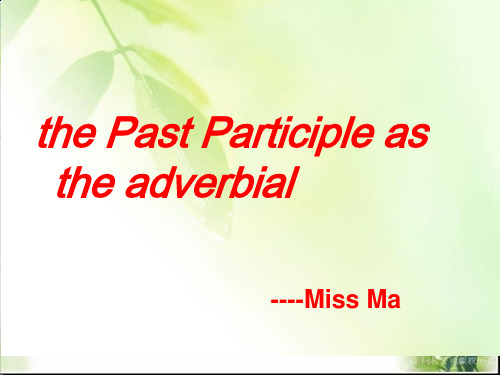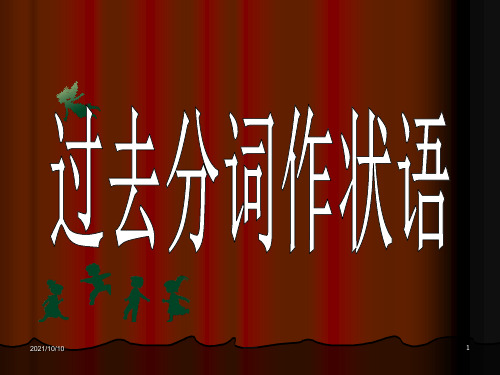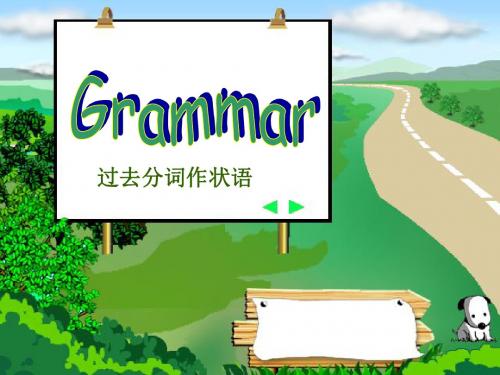过去分词作状语公开课课件82127
合集下载
最新过去分词做状语精品ppt课件

=When he was asked what …, he kept silent. Given more time, we would be able to do the work
much better. 条件
=If we were given more time, we would … Left alone at home, the little boy didn’t feel afraid at
classroom. (Though) working from morning till night, his father didn’t get enough money.
Revision: 现在分词做状语
(When)Walking in the street, I came across an old friend of mine. 时间
Using your head, you will find a way. = If you use your head, you …
Working from morning till night, his father didn’t get enough money.
= Although his father worked from …, he sat on the sofa and watched TV
过去分词 做状语
注意:
1. Worried about the journey, I was unsettled for the first few days.
2. Exhausted, I slid into bed and fell fast asleep.
被动, 完成
状态
√
much better. 条件
=If we were given more time, we would … Left alone at home, the little boy didn’t feel afraid at
classroom. (Though) working from morning till night, his father didn’t get enough money.
Revision: 现在分词做状语
(When)Walking in the street, I came across an old friend of mine. 时间
Using your head, you will find a way. = If you use your head, you …
Working from morning till night, his father didn’t get enough money.
= Although his father worked from …, he sat on the sofa and watched TV
过去分词 做状语
注意:
1. Worried about the journey, I was unsettled for the first few days.
2. Exhausted, I slid into bed and fell fast asleep.
被动, 完成
状态
√
必修五第三单元过去分词作状语课件

伴随状语
表示动作的伴随情况
过去分词作伴随状语,通常放在句首或句末,表示某个动作伴随另一个动作发生。例如,“He sat in the armchair, reading a book.”(他坐在扶手椅上,读着一本书。)
目的在句首或句末,表示某个动作 是为了达到某种目的而发生的。例如,“To get a better score, he studied hard for the exam.”(为了获得更好的 成绩,他努力学习准备考试。)
特点
过去分词作状语通常出现在句子的开 头,表示一种独立的结构,不依赖于 其他从句或句子成分。
常见用法
时间状语
原因状语
过去分词作时间状语通常用于表示某 个动作发生在主句谓语动作之前,如 “Having finished his homework, he went to bed.”
过去分词作状语可以表示某个动作或 状态是导致主句谓语动作发生的原因 ,如“Having failed the exam, he felt very upset.”
详细描述
例如,“Having been given a chance, he didn't hesitate for a second.”这句话中 ,过去分词“given”表示“被给机会”的动作发生在“didn’t hesitate”之前,但
整个句子的时态是过去时,与“given”所表示的过去的过去时态不匹配。
THANKS
感谢观看
04
过去分词作状语的练习与 解析
单项选择题解析
总结词
单项选择题是考察学生对过去分词作状 语的理解和应用能力的题型。
VS
详细描述
单项选择题通常会给出一段含有过去分词 作状语的句子,要求学生判断其语法正确 性或选择最合适的选项。这类题目要求学 生掌握过去分词的用法,理解其在句子中 的作用,并能够根据语境进行正确的判断 。
过去分词短语作状语(公开课)课件

详细描述
使用过去分词短语表示某个动作发生 后所产生的结果,例如"He studied hard and ended up getting a good grade."(他努力学习,最终取 得了良好的成绩。)
03
过去分词短语作状语的用 法
用于描述动作发生的原因
总结词
表示动作发生的原因
详细描述
过去分词短语可以用来描述某个动作发生的 原因,通常放在句首或句尾,用来补充说明
目的状 语
总结词
表示某个动作是为了达到某种目的而发生
详细描述
使用过去分词短语表示某个动作是为了达到某种目的而发生, 例如"To get a better job, he decided to further his education."(为了找到更好的工作,他决定继续深造。)
结果状语
总结词
表示某个动作发生后所产生的结果
单项选择题练习
要点一
总结词
通过单项选择题,学生可以熟悉过去分词短语作状语的常 见用法和语境。
要点二
详细描述
单项选择题通常会提供一段含有过去分词短语作状语的句 子,并要求学生从中选择正确的选项。这些选项通常包括 一个完整的句子和几个省略了某些成分的句子,学生需要 根据上下文语境和语法规则来判断哪个选项是正确的。
注意与相关从句的区别与联系
过去分词短语作状语与状语从 句在语法结构和意义上存在相 似之处,但也有明显的区别。
状语从句通常以连词引导,而 过去分词短语作状语则没有连 词引导。
在某些情况下,可以使用状语 从句来代替过去分词短语作状 语,但需要注意时态和语序的 调整。
05
过去分词短语作状语的练 习与巩固
使用过去分词短语表示某个动作发生 后所产生的结果,例如"He studied hard and ended up getting a good grade."(他努力学习,最终取 得了良好的成绩。)
03
过去分词短语作状语的用 法
用于描述动作发生的原因
总结词
表示动作发生的原因
详细描述
过去分词短语可以用来描述某个动作发生的 原因,通常放在句首或句尾,用来补充说明
目的状 语
总结词
表示某个动作是为了达到某种目的而发生
详细描述
使用过去分词短语表示某个动作是为了达到某种目的而发生, 例如"To get a better job, he decided to further his education."(为了找到更好的工作,他决定继续深造。)
结果状语
总结词
表示某个动作发生后所产生的结果
单项选择题练习
要点一
总结词
通过单项选择题,学生可以熟悉过去分词短语作状语的常 见用法和语境。
要点二
详细描述
单项选择题通常会提供一段含有过去分词短语作状语的句 子,并要求学生从中选择正确的选项。这些选项通常包括 一个完整的句子和几个省略了某些成分的句子,学生需要 根据上下文语境和语法规则来判断哪个选项是正确的。
注意与相关从句的区别与联系
过去分词短语作状语与状语从 句在语法结构和意义上存在相 似之处,但也有明显的区别。
状语从句通常以连词引导,而 过去分词短语作状语则没有连 词引导。
在某些情况下,可以使用状语 从句来代替过去分词短语作状 语,但需要注意时态和语序的 调整。
05
过去分词短语作状语的练 习与巩固
过去分词作状语公开课课件

Who is she?
Seen from the top, the National Stadium looks like a bird nest. Given another chance by God, I will say “I love you” to the girl.
Chosen to act as one of the four judges on it, Na ying is more famous than ever before.
(考点3) be done+介词作状语 去掉be动词 表示主语的状态,常见短语
be dressed in 穿着 be seated 就坐
be lost in沉浸在 be prepared for为…做准备
be devoted to 致力于 be stuck/caught in 被困在
be married to
注意
(考点1)过去分词作状语,其逻辑主 语就是句子的主语,过去分词表示 的动作与主语之间是被动关系 Given better attention, the trees could grow better.
如何找逻辑主语?
过去分词词虽不能作谓语,但仍具有动词特点 ,其逻辑上的动作执行者就叫做逻辑主语。
2.
in the early 20th century ,the school
keeps on inspiring children’s love of art. (2013
安徽卷)
A.To found B.Founding
C.Founded
go outing.
过去分词作状语考点
1.过去分词和句子主语是被动关系 2. 连词when, while, until, once, if,
Seen from the top, the National Stadium looks like a bird nest. Given another chance by God, I will say “I love you” to the girl.
Chosen to act as one of the four judges on it, Na ying is more famous than ever before.
(考点3) be done+介词作状语 去掉be动词 表示主语的状态,常见短语
be dressed in 穿着 be seated 就坐
be lost in沉浸在 be prepared for为…做准备
be devoted to 致力于 be stuck/caught in 被困在
be married to
注意
(考点1)过去分词作状语,其逻辑主 语就是句子的主语,过去分词表示 的动作与主语之间是被动关系 Given better attention, the trees could grow better.
如何找逻辑主语?
过去分词词虽不能作谓语,但仍具有动词特点 ,其逻辑上的动作执行者就叫做逻辑主语。
2.
in the early 20th century ,the school
keeps on inspiring children’s love of art. (2013
安徽卷)
A.To found B.Founding
C.Founded
go outing.
过去分词作状语考点
1.过去分词和句子主语是被动关系 2. 连词when, while, until, once, if,
高中英语语法——过去分词作状语(32张PPT)-经典通用课件资料

2021/10/10
9
The film star appeared, surrounded by a group of fans. =The film star appeared and was surrounded by a group of fans.
2021/10/10
10
用括号内所给动词的适当形式填空。
2021/10/10
7
4. 表示让步 表示让步,相当于although/though引导的让步状语从句.
ughed at by many people, he continued his study. 2.Badly wounded, he continued to fight.
Though he was laughed at by many people, he continued his study. Though he was badly wounded, he continued to fight.
2021/10/10
20
7. 现在分词、过去分词和不定式作状语的区别
2021/10/10
3
ห้องสมุดไป่ตู้
1.过去分词作时间状语
1. Seen under a microscope, a fresh snowflake has a delicate (精美的) shape. When it is seen under a microscope, a fresh snowflake(雪花) has a delicate shape.
3.Given good weather, our ship will reach Shanghai this evening. 假如天气好,我们的船将于今晚抵达上海。
过去分词作状语 专题课件(共34张PPT)

重难点辨析(二):不表被动的特殊情况 注意:
1. Worried about the journey, I was unsettled for the first few days. 2. Exhausted, I slid into bed and fell fast asleep.
被动, 完成
⑤ The old man went into the room, supported by his wife. (伴随或方式状语)
5.过去分词+连词 过去分词作状语,常常可以在过去分词前加 连词(when, if, though, once 等),以起到强 调的作用,使句意更加明确。
6. 过去分词状语,相当于一个状语从句。 (伴随状语相当于一个并列句)
一般地(坦率地/确切地)说; Considering… 考虑到……; Talking of… 说到….;
Supposing/ Provided/ Providing that… 假使….; To be honest, /To tell the truth, 老实说;说实话
______ from his accent, he must come from southern China. A. Judged; B. Judging ; C. To judge D. Judge
流连忘返
Revision: 现在分词做状语
一.过去分词作状语的基本用法: 被动 1. 过去分词与句子主语之间构成_______ 关系。
2. 过去分词的逻辑主语要和句子的主语一致。
3. 可置于主句前,也可置于主句后,用逗号与主句隔开。 4. 过去分词通常在句中充当以下几种状语:
① (When) Asked what had happened, he kept silent. (时间状语)
过去分词作状语课件

练习题五
总结词
综合运用过去分词作状语的能力
VS
详细描述
这道练习题要求学生综合运用过去分词作 状语的能力,通过写作和翻译练习,让学 生在实际运用中掌握过去分词作状语的用 法,提高语言表达能力。
THANKS
在某些情况下,如果需要强调动作或状态的完成或实现, 可以使用完成时态的过去分词形式,如“Having been done”。
注意与独立主格结构的区别
独立主格结构是指一个名词或代词作 为主语,与谓语动词不存在逻辑上的 主谓关系,而是通过非谓语动词的形 式表达动作或状态。
过去分词作状语时,其动作或状态与 句子主语存在逻辑上的主谓关系,因 此应与主句保持连贯和一致。
例如:“Speaking English, he could communicate with the native speakers.”(他说英语,能够与母语为英语的人交流。)“Having finished his work, he went home.”(完成工作后,他回家了。)
02
过去分词作状语的分类
过去分词作原因状语
1 2
原因状语的定义
用来表示某个动作或情况发生的原因或理由。
过去分词作原因状语的例子
Feeling tired, she decided to take a rest. (因 为感到累了,她决定休息一下。)
3
总结
过去分词作原因状语时,通常放在句首或句尾, 表示某个动作发生的原因或理由。
过去分词作让步状语
01
让步状语的定义
用来表示某个动作或情况发生的转折或让步。
02
过去分词作让步状语的例子
Although treated unfairly, he never complained. (尽管受到了不公
过去分词作状语公开课课件

Hearing 4)_______(hear)the news, they at once leave for Shanghai. Driving 5)_______(drive)too
fast, you will da语与现在分词作状语的区别在 于: 动宾关系 过去分词与句子主语构成____________, 而现 主谓关系 在分词与句子主语构成_____________ 。 判断正确:(T/F)
作方式或伴随状语
作状语表示方式或伴随情况时,过去分词可 用并列句代替
The old man walked in the park, supported by his wife.
The old man walked in the park and was supported by his wife.
作条件状语。相当于if, unless引导的条 件状语从句。
Given another chance, he will do better.
=
If he is given…
作让步状语。相当于though, although,even if 引导的让步状语从句。
即使被邀请,我也不会参加聚会。 Even if invited I will not take ______________, part in the party. =Even if (I am) invited, I ……
作时间状语。相当于一个时间状语从句。
Seen from the top of the hill, our school looks beautiful.
(= When it is seen from the top of the hill, our school looks beautiful. )
fast, you will da语与现在分词作状语的区别在 于: 动宾关系 过去分词与句子主语构成____________, 而现 主谓关系 在分词与句子主语构成_____________ 。 判断正确:(T/F)
作方式或伴随状语
作状语表示方式或伴随情况时,过去分词可 用并列句代替
The old man walked in the park, supported by his wife.
The old man walked in the park and was supported by his wife.
作条件状语。相当于if, unless引导的条 件状语从句。
Given another chance, he will do better.
=
If he is given…
作让步状语。相当于though, although,even if 引导的让步状语从句。
即使被邀请,我也不会参加聚会。 Even if invited I will not take ______________, part in the party. =Even if (I am) invited, I ……
作时间状语。相当于一个时间状语从句。
Seen from the top of the hill, our school looks beautiful.
(= When it is seen from the top of the hill, our school looks beautiful. )
过去分词作状语公开课课件

联系
在某些情况下,独立主格结构可以包 含过去分词作状语,例如在表示时间 、条件、伴随等情况时。
04
过去分词作状语的注意事项
BIG DATA EMPOWERS TO CREATE A NEW
ERA
时态问题
要点一
时态一致性
过去分词作状语时,句子的时态应与分词表示的动作发生 的时间保持一致。例如,“Having finished the work, he went home.”(完成工作后,他回家了。)句中过去分词 “finished”表示的动作发生在谓语“went”之前,因此 整句应使用过去完成时。
答案
finishing
解析
此处需要用过去分词作状语,表示“完成读书”这一动作发生在“上床睡觉”之前,因此 用“finishing”。
完形填空题
1 2
题目
He _______ in the library, but now he prefers to study at home.
答案
used to studying
逻辑关系问题
逻辑判断
在处理过去分词作状语的句子时,需要判断 分词与其逻辑主语之间的逻辑关系。例如, “He lay on the ground, surrounded by a group of people.”(他躺在地上,被一 群人围着。)这里过去分词 “surrounded”表示被动关系,即“他” 被“一群人围着”。
类型
01
02
0304时间状语来自表示动作发生的时间,通常放 在句首或句尾。
原因状语
表示动作发生的原因,通常放 在句首。
条件状语
表示动作发生的条件,通常放 在句首或句中。
方式状语
在某些情况下,独立主格结构可以包 含过去分词作状语,例如在表示时间 、条件、伴随等情况时。
04
过去分词作状语的注意事项
BIG DATA EMPOWERS TO CREATE A NEW
ERA
时态问题
要点一
时态一致性
过去分词作状语时,句子的时态应与分词表示的动作发生 的时间保持一致。例如,“Having finished the work, he went home.”(完成工作后,他回家了。)句中过去分词 “finished”表示的动作发生在谓语“went”之前,因此 整句应使用过去完成时。
答案
finishing
解析
此处需要用过去分词作状语,表示“完成读书”这一动作发生在“上床睡觉”之前,因此 用“finishing”。
完形填空题
1 2
题目
He _______ in the library, but now he prefers to study at home.
答案
used to studying
逻辑关系问题
逻辑判断
在处理过去分词作状语的句子时,需要判断 分词与其逻辑主语之间的逻辑关系。例如, “He lay on the ground, surrounded by a group of people.”(他躺在地上,被一 群人围着。)这里过去分词 “surrounded”表示被动关系,即“他” 被“一群人围着”。
类型
01
02
0304时间状语来自表示动作发生的时间,通常放 在句首或句尾。
原因状语
表示动作发生的原因,通常放 在句首。
条件状语
表示动作发生的条件,通常放 在句首或句中。
方式状语
《过去分词做状语》课件

过去分词做状语的分类
时间状语
表示动作发生的时间, 如“Having finished his homework, he
went to bed.”
条件状语
表示动作发生的条件, 如“Given more time, they could have done
better.”
方式状语
表示动作发生的方式, 如“She left the room,
注意事项
过去分词短语做时间状语通常放在句首,强调某个动作或状态发生 在主句动作之前。
过去分词做条件状语
条件状语的定义
01
表示某个动作或状态发生的条件。
过去分词做条件状语的例子
02
Given more time, they could have done better.(如果给予
更多的时间,他们本可以做得更好。)
注意事项
03
ቤተ መጻሕፍቲ ባይዱ
过去分词短语做条件状语通常放在句首,强调某个动作或状态
发生的条件。
过去分词做原因状语
原因状语的定义
表示某个动作或状态发生的原因。
过去分词做原因状语的例子
Feeling tired, she decided to take a nap.(由于感到疲劳,她决 定小睡一会儿。)
注意事项
过去分词短语做原因状语通常放在句首,强调某个动作或状态发生 的原因。
学习建议与展望
总结:学习过去分词做状语需要多加练习和运用,同 时要注意总结归纳和避免常见错误。
学生可以通过阅读英文原著、写作练习和语法练习等 方式来提高对过去分词做状语的理解和运用能力。同 时,要善于总结归纳,对于常见的错误和难点要特别 留意,并积极寻求解决方法。未来,随着英语教育的 不断发展和国际化程度的提高,过去分词做状语等高 级语法知识将会更加受到重视,希望学生们能够把握 机会,努力学习,不断提高自己的英语水平。
- 1、下载文档前请自行甄别文档内容的完整性,平台不提供额外的编辑、内容补充、找答案等附加服务。
- 2、"仅部分预览"的文档,不可在线预览部分如存在完整性等问题,可反馈申请退款(可完整预览的文档不适用该条件!)。
- 3、如文档侵犯您的权益,请联系客服反馈,我们会尽快为您处理(人工客服工作时间:9:00-18:30)。
2. 原因状语
Because the boy was greatly touched by his teacher’s words, he did a lot of things to help his classmates. Greatly touched by the teacher’s words…
4. 让步状语
Though they had been warned of the storm, the farmers were still working in the fields. Though warned of the storm…
Even if I’m invited, I won’t take part in the party. Even if invited…
The teacher stood there and was surrounded by the students.
The teacher stood there, surrounded by the students.
summary
过去分词作状语
过去分词在句子中可以作时间状语、原因状 语、伴随状语、条件状语和让步状语等。
Because he was surprised at what happened, Tom didn’t know what to do.
Surprised at what happened…
a time machine
3.If I am given a time machine , I will pay a visit to the future.
1. 过去分词作状语表示__被__动_的和/或__完__成__ 的动作,相当一个状语从句。
2. 过去分词作状语时其逻辑主语为主句的主语, 此时应注意语态要一致。
Practice: Change the following clauses into Past Participles. 1.Because she was given advice by the famous
2. Because it was done in a hurry, his homework was full of mistakes. Done of mistakes.
our future school
1.When our future school is seen from the space, our future school looks like a plate. Seen from the space, our future school looks like a plate.
The stolen bike belongs to Jack.
The glass is broken.
Mary heard her name called by a stranger.
1.作定语
过 去
2.作表语
分 词
3.作宾补
4.作状语
Grammar
过去分词作状语
Combine the two sentences
detective, the young lady was no longer afraid.
2.Because it was done in a hurry, his homework was full of mistakes.
3.When it is heated, ice will be changed into water.
4.If I am compared with you, we still have a long
way to go.
5.The hunter left his house, and he was followed by his dog.
Let’s check the answer
1. Because she was given advice by the famous detective, the young lady was no longer afraid. Given advice by the famous detective, the young lady was no longer afraid.
Given a time machine, I will pay a visit to the future.
3. 条件状语
If we were given more time, we could do it much better. Given more time…
If it is heated to a high temperature, water will change into vapor. Heated to a high temperature…
Don’t speak until spoken to.
Our future schoolbag 2. Because She is surprised at the schoolbag, she turns her head back to find out what happens.
Surprised at the schoolbag ,she turns her head back to find out what happens.
1. 时间状语
时间状语可在过去分词前加上连词when, while, until等。
When it is seen from the hill, the park looks very beautiful. Seen from the hill, Don’t speak until you are spoken to.
5. 方式、伴随状语 The teacher entered the classroom, and he was followed by a group of students. The teacher entered the classroom ,followed by a group of students.
